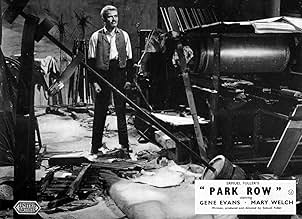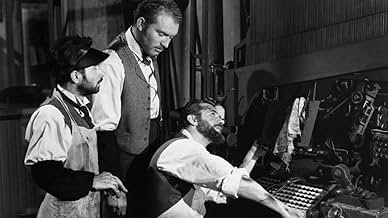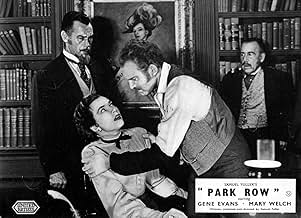Ajouter une intrigue dans votre langueThe Globe is a small, but visionary newspaper started by Phineas Mitchell, an editor recently fired by The Star. The two newspapers become enemies, and the Star's ruthless heiress Charity Ha... Tout lireThe Globe is a small, but visionary newspaper started by Phineas Mitchell, an editor recently fired by The Star. The two newspapers become enemies, and the Star's ruthless heiress Charity Hackett decides to eliminate the competition.The Globe is a small, but visionary newspaper started by Phineas Mitchell, an editor recently fired by The Star. The two newspapers become enemies, and the Star's ruthless heiress Charity Hackett decides to eliminate the competition.
- Réalisation
- Scénario
- Casting principal
- Jenny O'Rourke
- (as Tina Rome)
- Barfly
- (non crédité)
- Barfly
- (non crédité)
- Irate Liberty Fund Contributor
- (non crédité)
- Barfly
- (non crédité)
Avis à la une
The story is about a guy who is fired from one New York newspaper and decides to start his own. However, the deck is definitely stacked against him and a tough female newspaper owner seems willing to do anything to see his paper fail--and she takes this competition very personally. At first, she laughs off his attempts to put out a paper. But, when he starts seeing success after success, the competition becomes very dirty. In fact, the ugliness of this fight surprised me...it was THAT tough!
The film has some amazingly good camera-work--with great lighting and composition. It never looks cheap. Additionally, Evans is memorable as a tough guy who not only can out-think but out-punch his competition! His intensity is what makes the film. Overall, despite a few rough moments, it's a great textbook example that a film doesn't have to be expensive or filled with mega-stars to be a very good picture.
This is a completely fictional story, but it incorporates enough truth to be confusing. In the 1880s Park Row was newspaper row in New York City. There was a campaign that looks like crowdfunding today to finance the pedestal for the Statue of Liberty so the monument could be completed. There was an Ottmar Mergenthaler who invented the linotype machine, the first device that could easily and quickly set complete lines of type for use in printing presses. But all of these things did not take place under one roof for one newspaper. The film does have a pretty accurate depiction of newspaper printing as it occurred in the late 1800s, and that is the most interesting aspect of it.
I could deal with the confusion, but then there is the ham fisted romance/ sexual tension between The Star's Charity Hackett and The Globe's Phineas Mitchell. It reminded me of Hill Street Blues' romance between police captain Frank Furillo and public defender Joyce Davenport - If these two people really believe in what they are doing, how could they ever be attracted to one another? But then I am showing my age to explain a 70 year old movie in terms of a 40 year old TV show.
Overall, I'd recommend it. This was a passion project for Sam Fuller as he used his own money to produce it. Just be prepared for it to be a bit of an uneven ride.
The plot of "Park Row" is relatively thin. Gene Evans is the newspaper man who becomes the editor of a crusading newspaper in opposition to the more powerful paper from which he's just been fired. It is, in other words, a feelgood movie about a David triumphing over a mean old Goliath, (in this case represented by Mary Welch's excellent performance as the owner of the rival paper), but it's a populist picture with none of the sentimentality that Capra would have brought to it. Indeed, being a Sam Fuller picture, there's a fair amount of violence en route to the happy ending. It also has one of Fuller's best scripts; this is a movie full of crisp dialogue that makes great use of factual material. Amazingly, despite it's substantial critical reputation, it's seldom revived. Time, I think, to rectify that.
Never did Fuller create a film of such sheer energy and nostalgia. The film's tracking shots and frenetically-edited montages seem to get the most attention, but there are also some great monologues and magnificent performances, particularly from Mary Welch as the head of the "evil" newspaper, The Star, and Gene Evans as the leader of their opposing newspaper, The Globe.
The film has it's moments of campiness, but overall it's one of cinema's overlooked classics.
Le saviez-vous
- AnecdotesDirector Samuel Fuller put up his own money to make the movie and lost it all.
- GaffesApproximately 20 minutes into the film, there's a wall calendar showing the date as "1886 June 15 Monday." In 1886 June 15 was a Tuesday.
- Citations
Phineas Mitchell: The press is good or evil according to the character of those who direct it.
- Crédits fousInstead of "The End", the picture ends with "Thirty"; newspaper jargon for "that's all. There ain't no more!"
- ConnexionsFeatured in The Typewriter, the Rifle & the Movie Camera (1996)
Meilleurs choix
- How long is Park Row?Alimenté par Alexa
Détails
Box-office
- Budget
- 200 000 $US (estimé)
- Durée
- 1h 23min(83 min)
- Couleur
- Mixage
- Rapport de forme
- 1.37 : 1

































